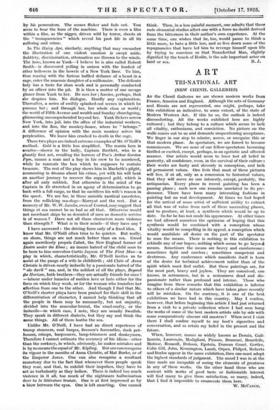ART
TRI-NATION A L ART
(NEW CIIENIL GALLERIES) AT the Chenil Galleries we are shown modern works from France, America and England. Although the arts of Germany and Russia are not represented, one might, perhaps, take this exhibition as indicative, to some extent, of the state of Modern Western Art. If this be so, the outlook is indeed discomforting. All the works exhibited here are highly cultured ; but they belong to a culture which seems to lack all vitality, enthusiasm, and conviction. No picture on the walls comes out to us and demands unquestioning acceptance. We linger in our step to admire, assess, or recognize this or that modern phase. As spectators, we are forced to become connoisseurs. We see none of our fellow-spectators becoming thrilled or excited, except, perhaps, in an egotistic and affected manner. Our artists would seem to have lost all belief in posterity, all confidence, even, in the survival of their culture : their works are hasty and slovenly in conception, and lack all permanent values. One feels that most of these pictures will live, if at all, only as a concession to historical values, that they will move no one intensely, except, probably, the antiquarian. Every phase in recent painting has been a passing phase ; each new one remains unrelated to its pre- decessor. There have been many interesting fashions in painting but no real development. At times we had hoped for the arrival of some artist of sufficient ability to extract all that was of value from each of these succeeding phases, and to produce, at least, a synthesis whith would be up to date. 'So far he has not made his appearance. At other times we had allowed ourselves the optimism of hoping that this synthesis would be combined with a conception whose vitality would be compelling in its appeal, a conception which would annihilate all desire on the part of the spectator to scan the means. There is nothing in this exhibition to rekindle any of our hopes ; nothing which seems to go beyoLd means. Sometimes the means are heavy and cumbersome ; sometimes light and careless ; sometimes competent and dexterous. Any exuberance which manifests itself is born of the desire for technical achievement rather than of the spirit which must find outlet. But these paintings are, for the most part, heavy and joyless. They are conceived, one knows, in seriousness, but in a seriousness dead and dis- passionate rather than profound and intense. Those who imagine from these remarks that this exhibition is inferior to others of a similar nature which have taken place recently will be mistaken. On the contrary, it is one of the best exhibitions we have had in this country. May I confess, however, that before beginning this article I had just returned from a visit to a private collection where I had seen hung the works of some of the best modern artists side by side with some comparatively obscure old masters ? When next I visit there I shall confine myself to my host's cigarettes and conversation, and so retain my belief in the present and the future.
When, however, names so widely known as Derain, Guil- laumin, Laurencin, Modigliani, Picasso, Brancusi, Boindelle, Matisse, Rouault, Dobson, Epstein, Duncan Grant, Gertler, Colin Gill, John, Kennington, Lamb, Orpen, Philpot, Roberts and Burhn appear in the same exhibition, then one must adopt the highest standards of judgment. The mood I was in at the time made me incapable of seeing the elements of greatness in any of; these _works. On the other hand those who are content with works of good taste or fashionable interest will find many to give them satisfaction, so many, indeed, that I find it impossible to enumerate them here.
- W. MCCANCE.


















































 Previous page
Previous page